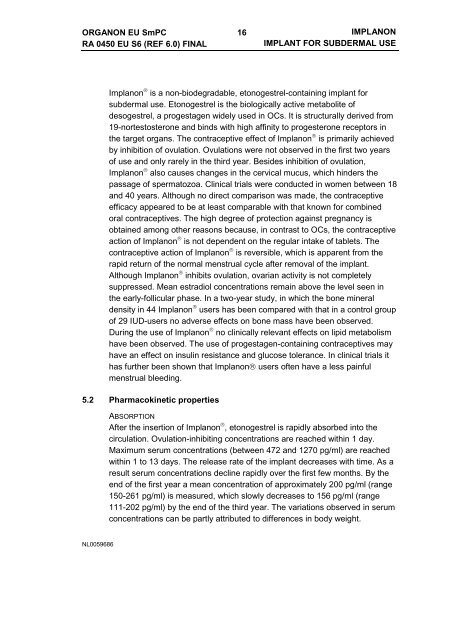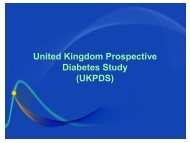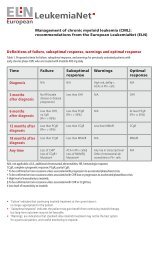IMPLANON IMPLANT FOR SUBDERMAL USE ... - epgonline.org
IMPLANON IMPLANT FOR SUBDERMAL USE ... - epgonline.org
IMPLANON IMPLANT FOR SUBDERMAL USE ... - epgonline.org
Create successful ePaper yourself
Turn your PDF publications into a flip-book with our unique Google optimized e-Paper software.
ORGANON EU SmPC<br />
RA 0450 EU S6 (REF 6.0) FINAL<br />
16<br />
<strong>IMPLANON</strong><br />
<strong>IMPLANT</strong> <strong>FOR</strong> <strong>SUBDERMAL</strong> <strong>USE</strong><br />
Implanon ® is a non-biodegradable, etonogestrel-containing implant for<br />
subdermal use. Etonogestrel is the biologically active metabolite of<br />
desogestrel, a progestagen widely used in OCs. It is structurally derived from<br />
19-nortestosterone and binds with high affinity to progesterone receptors in<br />
the target <strong>org</strong>ans. The contraceptive effect of Implanon ® is primarily achieved<br />
by inhibition of ovulation. Ovulations were not observed in the first two years<br />
of use and only rarely in the third year. Besides inhibition of ovulation,<br />
Implanon ® also causes changes in the cervical mucus, which hinders the<br />
passage of spermatozoa. Clinical trials were conducted in women between 18<br />
and 40 years. Although no direct comparison was made, the contraceptive<br />
efficacy appeared to be at least comparable with that known for combined<br />
oral contraceptives. The high degree of protection against pregnancy is<br />
obtained among other reasons because, in contrast to OCs, the contraceptive<br />
action of Implanon ® is not dependent on the regular intake of tablets. The<br />
contraceptive action of Implanon ® is reversible, which is apparent from the<br />
rapid return of the normal menstrual cycle after removal of the implant.<br />
Although Implanon ® inhibits ovulation, ovarian activity is not completely<br />
suppressed. Mean estradiol concentrations remain above the level seen in<br />
the early-follicular phase. In a two-year study, in which the bone mineral<br />
density in 44 Implanon ® users has been compared with that in a control group<br />
of 29 IUD-users no adverse effects on bone mass have been observed.<br />
During the use of Implanon ® no clinically relevant effects on lipid metabolism<br />
have been observed. The use of progestagen-containing contraceptives may<br />
have an effect on insulin resistance and glucose tolerance. In clinical trials it<br />
has further been shown that Implanon® users often have a less painful<br />
menstrual bleeding.<br />
5.2 Pharmacokinetic properties<br />
ABSORPTION<br />
After the insertion of Implanon ® , etonogestrel is rapidly absorbed into the<br />
circulation. Ovulation-inhibiting concentrations are reached within 1 day.<br />
Maximum serum concentrations (between 472 and 1270 pg/ml) are reached<br />
within 1 to 13 days. The release rate of the implant decreases with time. As a<br />
result serum concentrations decline rapidly over the first few months. By the<br />
end of the first year a mean concentration of approximately 200 pg/ml (range<br />
150-261 pg/ml) is measured, which slowly decreases to 156 pg/ml (range<br />
111-202 pg/ml) by the end of the third year. The variations observed in serum<br />
concentrations can be partly attributed to differences in body weight.<br />
NL0059686
















